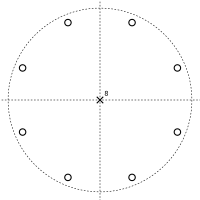
A | B | C | D | E | F | G | H | CH | I | J | K | L | M | N | O | P | Q | R | S | T | U | V | W | X | Y | Z | 0 | 1 | 2 | 3 | 4 | 5 | 6 | 7 | 8 | 9

In signal processing, a comb filter is a filter implemented by adding a delayed version of a signal to itself, causing constructive and destructive interference. The frequency response of a comb filter consists of a series of regularly spaced notches in between regularly spaced peaks (sometimes called teeth) giving the appearance of a comb.
Comb filters exist in two forms, feedforward and feedback; which refer to the direction in which signals are delayed before they are added to the input.
Comb filters may be implemented in discrete time or continuous time forms which are very similar.
Applications

Comb filters are employed in a variety of signal processing applications, including:
- Cascaded integrator–comb (CIC) filters, commonly used for anti-aliasing during interpolation and decimation operations that change the sample rate of a discrete-time system.
- 2D and 3D comb filters implemented in hardware (and occasionally software) in PAL and NTSC analog television decoders, reduce artifacts such as dot crawl.
- Audio signal processing, including delay, flanging, physical modelling synthesis and digital waveguide synthesis. If the delay is set to a few milliseconds, a comb filter can model the effect of acoustic standing waves in a cylindrical cavity or in a vibrating string.
- In astronomy the astro-comb promises to increase the precision of existing spectrographs by nearly a hundredfold.
In acoustics, comb filtering can arise as an unwanted artifact. For instance, two loudspeakers playing the same signal at different distances from the listener, create a comb filtering effect on the audio.[1] In any enclosed space, listeners hear a mixture of direct sound and reflected sound. The reflected sound takes a longer, delayed path compared to the direct sound, and a comb filter is created where the two mix at the listener.[2] Similarly, comb filtering may result from mono mixing of multiple mics, hence the 3:1 rule of thumb that neighboring mics should be separated at least three times the distance from its source to the mic.[citation needed]
Discrete time implementation
Feedforward form

The general structure of a feedforward comb filter is described by the difference equation:
where is the delay length (measured in samples), and α is a scaling factor applied to the delayed signal. The z transform of both sides of the equation yields:
The transfer function is defined as:
Frequency response


The frequency response of a discrete-time system expressed in the z-domain is obtained by substitution where is the imaginary unit and is angular frequency. Therefore, for the feedforward comb filter:
Using Euler's formula, the frequency response is also given by
Often of interest is the magnitude response, which ignores phase. This is defined as:
In the case of the feedforward comb filter, this is:
The term is constant, whereas the term varies periodically. Hence the magnitude response of the comb filter is periodic.
The graphs show the periodic magnitude response for various values of Some important properties:
- The response periodically drops to a local minimum (sometimes known as a notch), and periodically rises to a local maximum (sometimes known as a peak or a tooth).
- For positive values of the first minimum occurs at half the delay period and repeats at even multiples of the delay frequency thereafter:
- The levels of the maxima and minima are always equidistant from 1.
- When the minima have zero amplitude. In this case, the minima are sometimes known as nulls.
- The maxima for positive values of coincide with the minima for negative values of , and vice versa.
Impulse response
The feedforward comb filter is one of the simplest finite impulse response filters.[3] Its response is simply the initial impulse with a second impulse after the delay.
Pole–zero interpretation
Looking again at the z-domain transfer function of the feedforward comb filter:
the numerator is equal to zero whenever zK = −α. This has K solutions, equally spaced around a circle in the complex plane; these are the zeros of the transfer function. The denominator is zero at zK = 0, giving K poles at z = 0. This leads to a pole–zero plot like the ones shown.
 |
 |
Feedback form

Similarly, the general structure of a feedback comb filter is described by the difference equation:
Antropológia
Aplikované vedy
Bibliometria
Dejiny vedy
Encyklopédie
Filozofia vedy
Forenzné vedy
Humanitné vedy
Knižničná veda
Kryogenika
Kryptológia
Kulturológia
Literárna veda
Medzidisciplinárne oblasti
Metódy kvantitatívnej analýzy
Metavedy
Metodika
Text je dostupný za podmienok Creative
Commons Attribution/Share-Alike License 3.0 Unported; prípadne za ďalších
podmienok.
Podrobnejšie informácie nájdete na stránke Podmienky
použitia.
www.astronomia.sk | www.biologia.sk | www.botanika.sk | www.dejiny.sk | www.economy.sk | www.elektrotechnika.sk | www.estetika.sk | www.farmakologia.sk | www.filozofia.sk | Fyzika | www.futurologia.sk | www.genetika.sk | www.chemia.sk | www.lingvistika.sk | www.politologia.sk | www.psychologia.sk | www.sexuologia.sk | www.sociologia.sk | www.veda.sk I www.zoologia.sk



















